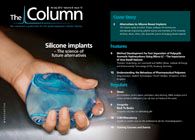Supplement analysis
Methylhexaneamine (MHA) has been in the news recently and it continues to be debated whether it is actually a constituent of geranium.

Methylhexaneamine (MHA) has been in the news recently and it continues to be debated whether it is actually a constituent of geranium. In a comprehensive analysis, a team of scientists has presented evidence that it is not present in the plant in detectable amounts.1
MHA has been marketed as a dietary supplement based on the argument that it is a constituent of geranium (Pelargonium graveolens) leaves, stems, roots or oil. The team developed two analytical methods for the analysis of MHA in P. graveolens using gas chromatography–mass spectrometry (GC–MS) and liquid chromatography–tandem mass spectrometry (LC–MS–MS). The results were further confirmed using liquid chromatography–high-resolution mass spectrometry. Twenty commercial volatile oils, three authenticated volatile oils and authenticated P. graveolens leaves and stems were analysed. In addition, three dietary supplements containing MHA which claimed P. graveolens as the source were analysed for their MHA content.
The results obtained demonstrated that none of the authenticated P. graveolens essential oils or plant material, nor the commercial volatile oils of contained MHA at detectable levels (limit of detection = 10 ppb). In contrast, the dietary supplements that contained MHA as one of their ingredients contained very large amounts of MHA. These amounts are not compatible with the use of reasonable amounts of P. graveolens extract or concentrate. The team ultimately concluded that this must be because the MHA was of a synthetic origin.
Mahmoud A. ElSohly et al., Journal of Analytical Toxicology doi: 10.1093/jat/bks055 (2012).
This story originally appeared in The Column. Click here to view that issue.

New TRC Facility Accelerates Innovation and Delivery
April 25th 2025We’ve expanded our capabilities with a state-of-the-art, 200,000 sq ft TRC facility in Toronto, completed in 2024 and staffed by over 100 PhD- and MSc-level scientists. This investment enables the development of more innovative compounds, a broader catalogue and custom offering, and streamlined operations for faster delivery. • Our extensive range of over 100,000 high-quality research chemicals—including APIs, metabolites, and impurities in both native and stable isotope-labelled forms—provides essential tools for uncovering molecular disease mechanisms and exploring new opportunities for therapeutic intervention.
New Guide: Characterising Impurity Standards – What Defines “Good Enough?”
April 25th 2025Impurity reference standards (IRSs) are essential for accurately identifying and quantifying impurities in pharmaceutical development and manufacturing. Yet, with limited regulatory guidance on how much characterisation is truly required for different applications, selecting the right standard can be challenging. To help, LGC has developed a new interactive multimedia guide, packed with expert insights to support your decision-making and give you greater confidence when choosing the right IRS for your specific needs.

.png&w=3840&q=75)

.png&w=3840&q=75)



.png&w=3840&q=75)



.png&w=3840&q=75)










